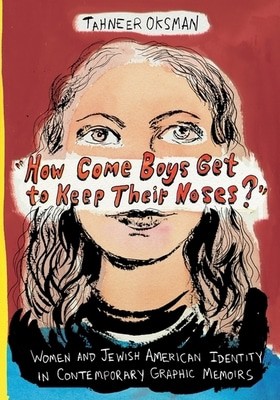
"How come boys get to keep their noses?" - Tahneer Oksman

"How come boys get to keep their noses?" - women and Jewish American identity in contemporary graphic memoirs
Tahneer Oksman
Hardback
Columbia University Press
English
20160301
American comics reflect the distinct sensibilities and experiences of the Jewish American men who played an outsized role in creating them, but what about the contributions of Jewish women? Focusing on the visionary work of seven contemporary female Jewish cartoonists, Tahneer Oksman draws a remarkable connection between innovations in modes of graphic storytelling and the unstable, contradictory, and ambiguous figurations of the Jewish self in the postmodern era.
Oksman isolates the dynamic Jewishness that connects each frame in the autobiographical comics of Aline Kominsky Crumb, Vanessa Davis, Miss Lasko-Gross, Lauren Weinstein, Sarah Glidden, Miriam Libicki, and Liana Finck. Rooted in a conception of identity based as much on rebellion as identification and belonging, these artists' representations of Jewishness take shape in the spaces between how we see ourselves and how others see us. They experiment with different representations and affiliations without forgetting that identity ties the self to others. Stemming from Kominsky Crumb's iconic 1989 comic "Nose Job," in which her alter ego refuses to assimilate through cosmetic surgery, Oksman's study is an arresting exploration of invention in the face of the pressure to disappear.
We are Rated Excellent on Trustpilot
Here's what you say about us...
We are Rated Excellent on Trustpilot
Here's what you say about us...
Tahneer Oksman is assistant professor and director of the Writing Program at Marymount Manhattan College. She has published articles in a/b: Auto/Biography Studies, Studies in Comics, and Studies in American Jewish Literature, as well as the Forward, the Los Angeles Review of Books, and Cleaver Magazine, where she is the graphic narratives reviews editor.
A careful and nuanced exploration of the complexities of identity and identification, "How Come Boys Get to Keep Their Noses?" is an excellent and ground-breaking work, invaluable to scholars of Jewish studies, comics studies, and women's studies.
Jeremy Dauber, Director, Institute for Israel and Jewish Studies, Columbia University
As a cartoonist who is a woman and who happens to be a non-Jew, I love this book, and completely identify with Oksman's theories of the deep intersectionality of these issues. She examines the beauty of how cartoons and graphic narrative can uncover difficult, personal ideas so masterfully. Oksman helps the reader see the art and struggles of a group of talented women as they search for honest identity and a place to call home.
Liza Donnelly, cartoonist, author of When Do They Serve the Wine?: The Folly, Flexibility, and Fun of Being a Woman
An original study that charts how three indisputably fascinating subjects-feminism, Judaism, and comics-intersect today. In Oksman's analysis, the word-and-image form, comics, and the identities it presents on its pages are connected: they both resist overdetermination, refiguring traditional categories and taxonomic pressures. A unique and compelling addition to several different fields.
Hillary L. Chute, University of Chicago, author of Graphic Women: Life Narrative and Contemporary Comics
A brilliant analysis. Oksman's readings are as nuanced and inventive as the artists she describes.
Joyce Antler, Brandeis University
For those interested in the graphic form, [Oksman] provides ample observations and insights into the construction of female Jewish identity.
Jewish Book Council - Ada Brunstein
Tahneer Oksman's study "How Come Boys Get to Keep Their Noses?": Women and Jewish American Identity in Contemporary Graphic Memoirs is a welcome reminder that, in comics that appear on the page as well as comics who get up on stage, Jewish women are insisting we reckon with their bawdy bodies.
The Forward - Marissa Brostoff
Tahneer Oksman's "How Come Boys Get to Keep Their Noses?" offers a new way to think about Jewish identity in America.
Contemporary Jewry - Rachel Gordan
Oksman challenges readers to transform their understanding of the comic format - to see the serious exploration that underlies the cartoonist's work. I certainly will never look at a graphic novel or memoir in quite the same way again.
The Reporter
Oksman is superb at interpreting visual and narrative details, and she provides elegant links back and forth between the cartoonists.
Contemporary Women's Writing - Candida Rifkind
Oksman's work helps illuminate the ways in which Jewish women artists in particular have negotiated, subverted, reclaimed or straight-out rejected stereotypical expectations of what being 'American', 'Jewish' and 'female' means in twentieth and twenty-first century society and culture.
Life Writing - F. K. Clementi
An insightful... generously illustrated volume, brimming with startling and provocative images.
Jewish Renaissance - Ranen Omer-Sherman
An impressive book.
Metapsychology - Sharon Packer, MD
Detailed and insightful. . . . [Oksman's] excellent analysis of the combination of text and art in each of the works reveals the suitability and uniqueness of the graphic format for memoirs as well as fiction. Overall, Oksman's is a worthwhile book, highly recommended for all libraries with or without graphic narrative collections.
Tulsa Studies in Women's Literature - Stephen E. Tabachnick
"How Come Boys Get to Keep Their Noses?" makes an essential contribution to scholarship on American Jewish literature and the Jewish graphic novel. In bringing together questions of gender and Jewishness to discuss these contemporary comics, Oksman expands the terms of analysis for discussing not just graphic narratives but, more broadly, Jewish literature and culture in a visual age.
American Jewish History - Melissa Weininger
[An] insightful book that might function best as a map for making sense of a highly diffuse and dispersed genre in which the central (dare I say canonical?) texts are already complex acts of representation. Oksman's guide to them adds another layer of representation and reflection that deepens our understanding of the books and the complex of identities that they already represent.
Shofar: An Interdisciplinary Journal of Jewish Studies - Ari Y. Kelman












